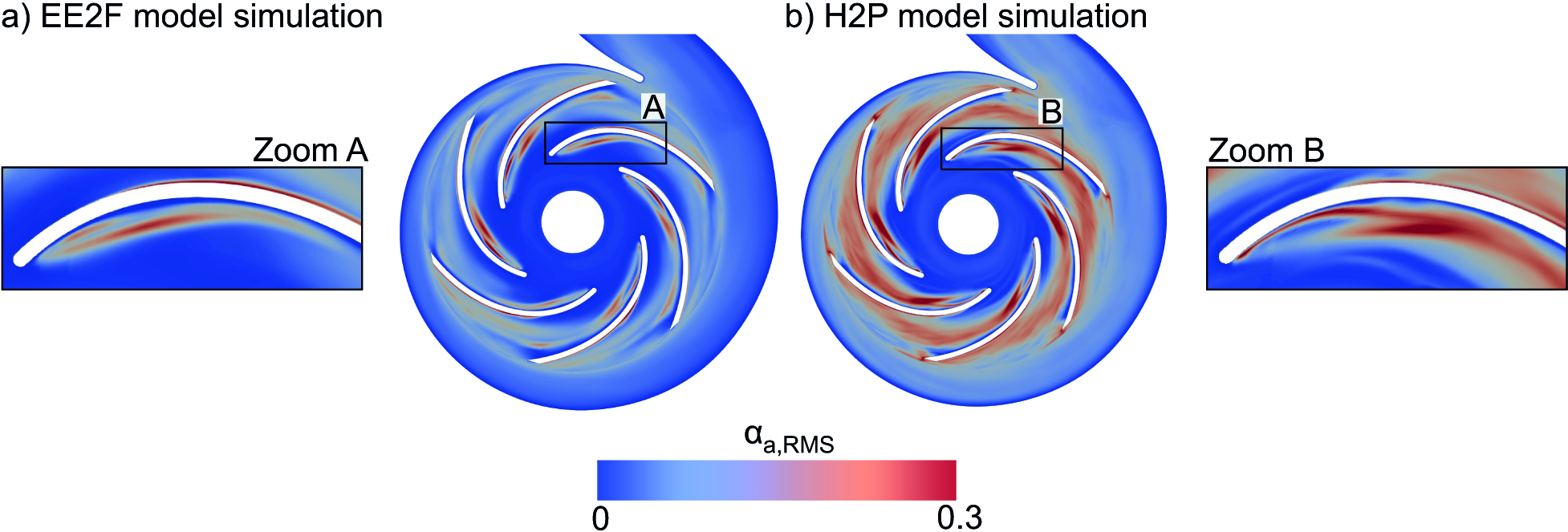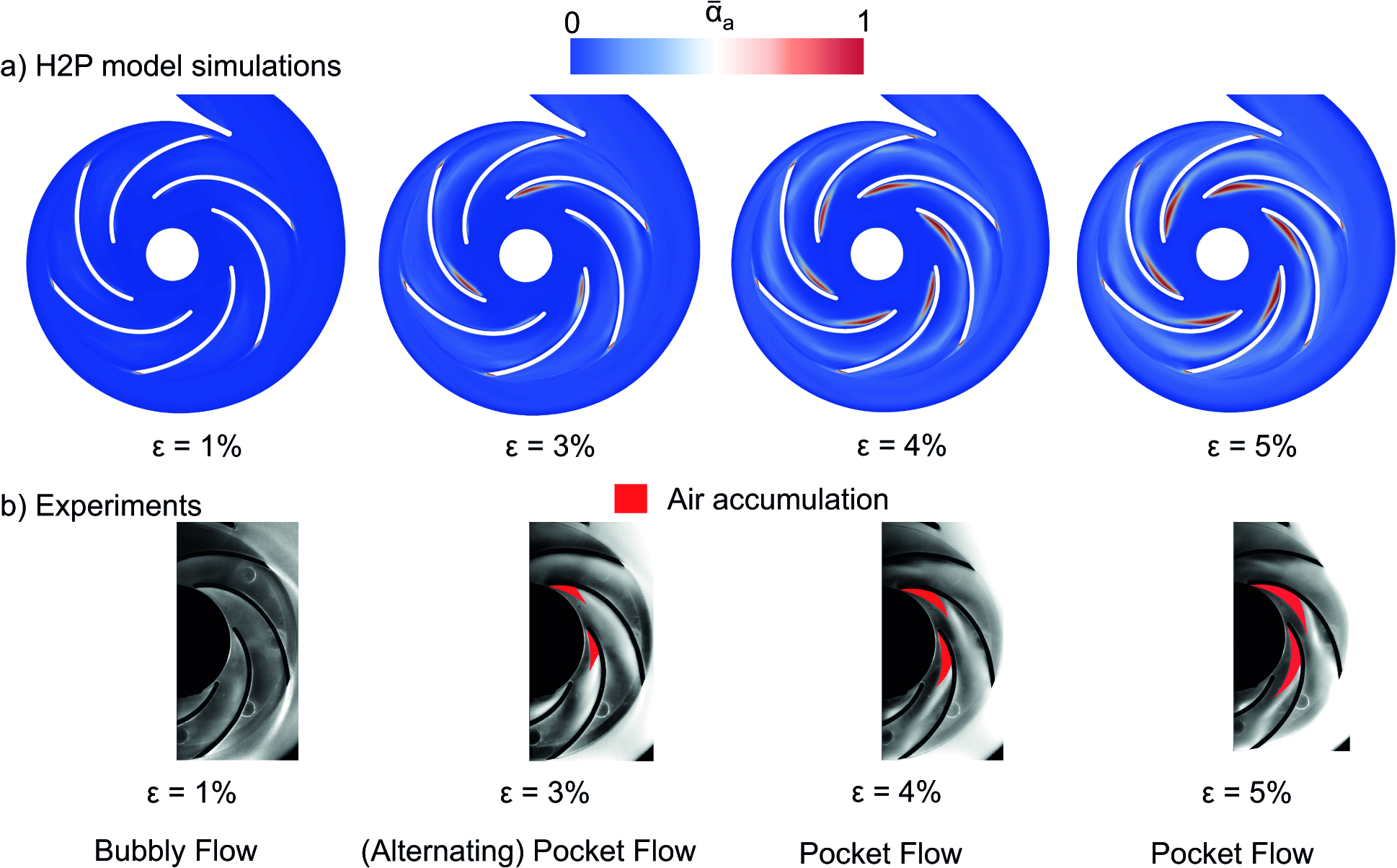Project
Gas-liquid flow delivery with centrifugal pumps
Centrifugal pumps are employed in various industrial and engineering applications to transport two-phase mixtures as liquid and non-condensable gas. Several examples of the two-phase pump operation can be found, e.g., in the chemical and process industry or geothermal power stations. In recent optical flow measurements of our project partners from the University of Magdeburg on a transparent volute-type radial centrifugal pump, an accumulation of air bubbles to adherent gas pockets within the impeller blade channels was observed [5]. A transition of unsteady bubbly flow towards an attached gas pocket at the blade suction side was found for increasing water’s air loading. Due to the presence of these attached gas pockets, the water is guided inefficiently through the blade passages, which may result in a drop in pump performance and pump surging.
Project Details
Project term
October 1, 2020–September 30, 2021
Affiliations
Ruhr University Bochum
Institute
Chair of Hydraulic Fluid Machinery
Principal Investigator
Methods
Predicting two-phase flows in centrifugal pumps with state-of-the-art computational fluid dynamic (CFD) methods is only possible by accepting significant uncertainties. We could show that the standard Euler-Euler two-fluid (EE2F) model for the simulation of dispersed bubbles can only approximately capture the pump performance drop, partially with a qualitative mismatch of the location of gas accumulation within the impeller [2]. On the other hand, an interphase-resolving model in terms of the volume-of-fluid (VOF) approach is appropriate to resolve the liquid-gas interface and the coherent gas aggregation if a sufficient spatial grid resolution is provided. However, with the VOF model, it was possible to resolve coherent void structures with the employed computational grids, but finely dispersed gas bubbles could not be resolved [3]. Therefore, a proper head drop could not be captured [3]. The resolution of the disperse phase within the VOF approach
would lead to an extremely high computational effort, which cannot be guaranteed even by current HPC systems. Based on these findings, a hybrid two-phase (H2P) flow solver was adopted within this study, which features VOF properties when air accumulations form, while the EE2F approach is used in the dispersed part of the flow. For the time being, a monodisperse bubble size distribution is applied in the dispersed flow region. An extension to polydisperse population balance modeling will be undertaken in the next step. In the measurements, a high unsteadiness of the two-phase flow was observed [5]. For centrifugal pump flows, we could show that a scale-adaptive simulation model can directly resolve large turbulent structures down to the local grid cell size and is more beneficial than standard statistical URANS turbulence models for predicting highly unsteady flow regions [1]. Therefore, a scale-adaptive turbulence model is utilized in this study.
Results
The simulation results reveal that the prediction of coherent gas pockets in centrifugal pump impellers is significantly improved by dynamically introducing the interphase sharpening within the H2P approach [4]. The better prediction of gas pockets with the H2P model compared to the EE2F model is exemplarily shown in Figure 1. The temporal standard deviation of the air volume fraction 𝛼a,RMS is presented for an inlet air volume fraction of 𝜀 = 5%. While the temporal variation of the gas pockets within the EE2F model simulation reflects the behavior of the agglomerated bubbles flow regime, the H2P model simulation shows steady gas pockets with an unsteady wake. This behavior reflects the temporal characteristics of the gas pockets observed in the measurements, and this flow morphology is called pocket flow regime [5].
The transition from bubbly via alternating pocket flow to steady pocket flow could also be captured within the H2P model simulations, which goes clearly beyond the capabilities of conventional EE2F and VOF methods [4]. A sample comparison of contour plots at impeller midspan of time-averaged air volume fraction 𝛼𝑎̅̅̅ _in the H2P model simulations and the experimental observed ensemble-averaged accumulation zones for different 𝜀 _is presented in Figure 2. A very good agreement between simulation results and measurement data is observable for the investigated operation range, and the transition of flow regimes was captured well by the H2P model simulations.
Discussion
While the capabilities of an H2P approach for pump flows could be shown for the first time, remaining uncertainties are primarily traced back to the assumption of an invariant bubble diameter in the monodisperse air phase. Therefore, in the next step, we intend to use a population balance model together with breakup and coalescence kernels to reflect the polydisperse bubble spectrum. The question will be answered if the polydisperse modeling increases the predictability of the CFD method or if a recalibration of bubble interaction models for two-phase pump flows is necessary. The above-presented results were published in a journal publication [4] and a conference proceeding [3]. A further journal publication of our project partners from TU Darmstadt, using the same H2P model for horizontal diffusor flow simulations, is currently under review [6].
Additional Project Information
DFG classification: 404 Fluid Mechanics, Technical Thermodynamics and Thermal Energy Engineering
Publications
Hundshagen, M., Rave, K., Nguyen, B., Popp, S., Hasse, C., Mansour, M., Thevenin, D., Skoda, R. (2022). Two-Phase Flow Simulations of Liquid/Gas Transport in Radial Centrifugal Pumps with Special Emphasis On the Transition From Bubbles to Adherent Gas Accumulations. ASME Journal of Fluids Engineering 2022, 144(10), 101202. DOI: 10.1115/1.4054264.
Hundshagen, M., Rave, K., Mansour M., Thévenin, D. & Skoda, R. (2021). Assessment of multi-phase CFD methods for gas-laden liquid flows in centrifugal pumps with particular emphasis on the change of flow morphology. Proc. 14th European Conference on Turbomachinery Fluid Dynamics & Thermodynamics (ETC14), Paper-ID: ETC2021-529, Gdansk, Poland, April 12-16, 2021. DOI: 10.29008/ETC2021-529.

